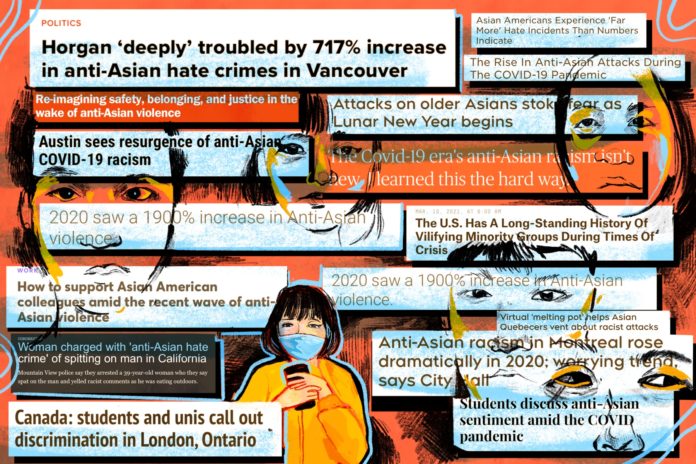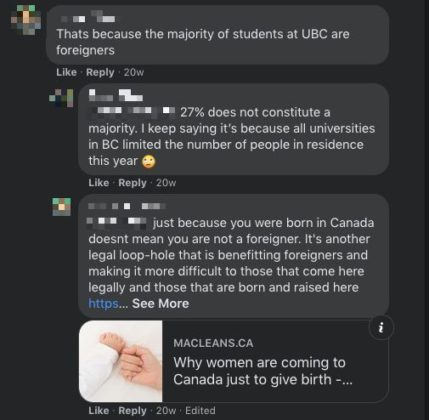I’m no longer sure whether I’m angry or afraid.
In the past year, there has been a wave of hate crimes including murders, beatings, attacks, and outright violence against Asian people all over the world. Many of these violent actions were carried out against Asian elders, often the most vulnerable members of our community. For me, this includes my parents, my aunts and uncles, and other members of the Vietnamese community that I have grown up with.
A significant amount of data attributes these sudden hateful crimes to COVID-19’s origin in China. People now associate an entire race with a pandemic-causing illness because of the country of discovery. While it may be partly true that these sudden bouts of violence are the result of the pandemic, to me, this is a violent manifestation of the past 200 years of history surrounding Asian presence in the West.
Historic and contemporary examples of anti-Asian racism by the west are not hard to find. The west has actively colonized the majority of Southeast Asia, forced the presence of its military in countries like Japan and Vietnam (driving their residents to immigrate west), and turned Asian nations like Thailand and the Philippines into hotbeds of sex tourism. Each of these cases demonstrate how the global North has always treated Asian nations and people with a mix of hatred and control.
Sensationalized fear and hatred towards Asian people is nothing new. Even before COVID-19, one simply had to view the comments of any news article written about Canada’s housing situation to see it. (Bonus points if the news article was focused on Vancouver or Toronto.)
Even after more than a century of immigration and contribution to Canadian society, Asian people are still ‘othered’ in more ways than one.
In Canada, Asian people have long been considered a monolith, an exotic ‘other’ that makes for interesting capitalistic ventures. Our cuisines are good enough to eat and bastardize, our cultural clothing sexualized and worn without invitation, and our retail businesses are deemed appropriate to frequent (pre-COVID-19, of course).
To make matters worse, our stories are often reduced to the model minority myth, which looks at the success of some East Asians—judges them for having a good education, a solid income, and a stable home life—and concludes that all minorities should be able to pull themselves up by their bootstraps.
Never mind that it ignores South East Asian and South Asian struggles. Never mind that the Canadian immigration rules create skewed advantages for East Asians, like possessing specialized skills, higher education or money to apply for a visa.
The model minority myth deliberately sets up Asian people against other minorities. It allows mainstream news and the government to under-report these hate crimes and not take them seriously, because Asian immigrants are seen as too well-off in Canada to face continued prejudice as the country’s ‘model minorities.’
Some have asked why Asian people have kept quiet before or why we are just speaking up now. Coverage of Asian diaspora filters many lived experiences into one monolith of East Asian culture. The truth is that the diverse array of cultures the Asian diaspora is composed of has created a divide between the lived experiences of Asian people with different backgrounds.
Our communities are often so distinct and separate, it has left us without organization or mobilization as a whole. It took frequent and violent attacks against members of our community—particularly our elders—for us to unite and for our voices to be heard within the mainstream media.
It is essential that non-Asians stick up for Asian Canadians. They must make an effort to amplify Asian voices, call for justice for the victims of anti-Asian hate crimes, donate to local charities whose missions are to help varying Asian communities, call out those in your life and communities that harbour racist sentiments, and support local Asian businesses. It could save our lives.
In the past year, I’ve seen people I know in real life get called ‘coronavirus’ as a taunt. I also know people who have been attacked in some way or whose businesses have been struggling. It is terrifying to know that people are taking their pandemic rage out on Asian people, especially Asian elders, simply because they can.
It is even more terrifying to me that if my parents or my relatives crossed the path of the wrong person, their lives would be in danger.
The microaggressions and internal dialogue that I and other Asian people have experienced did not start with the pandemic—they were magnified by it. Did that person give me a dirty look for a reason? Is it because I’m Asian? Is it because they think I have the virus? Do they think I have the virus because I’m Asian?
I have been afraid to cough in public and even to get help while sick with other illnesses for fear someone would accuse me of spreading the virus. It doesn’t matter that I’m not Chinese or even East Asian. If someone sees me as Asian, they’re not going to check my ethnicity before they beat me.
Our community doesn’t need people to just ‘recognize’ the racism we face. What is needed is an acknowledgement of the history of colonization, violence, exploitation and Sinophobia that remains embedded in our societal network today. What is needed is a dismantling of these systems that silence and exploit us and for people and allies to listen to the needs of our communities and demand change.
What we need right now is to protect Asian lives.
Featured graphic by Sara Mizannojehdehi.









